How Do Plants Move? The Sensitive Plant.
Introduction
Most of the time, plants move very slowly. Normally, you wouldn't expect a plant to move out of the way if you touch it. Luckily for us, nature is full of surprises.
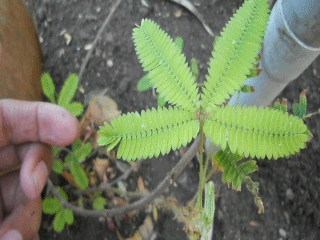
The picture features a sensitive plant (Mimosa pudica) which is native to South America. Sensitive plants can rapidly move their leaves and even branches when they sense something touching them. Many scientists think this gives it an advantage against herbivores and insects[1]. In this post we'll look at how Mimosa pudica senses and responds to touch.
How Does Mimosa pudica Detect Touch?
These plants can even tell the difference between wind and insects.
Just like the Venus flytrap, scientists found that sensitive plants can be triggered with either physical touch or electrical shocks [2]. Whenever sensitive plants are triggered, an electrical pulse can be measured within the plant[3]. How can plants send electrical signals long distances without nerve cells?
Plants have unique structures called plasmodesmata connecting neighboring cells. The plasmodesmata are proteins that look similar to a tube through which water and small molecules can freely flow [4]. This results in a continuum of cytoplasm which is called the symplast. In the case of plants, electrical signals can travel between adjacent cells through these connections.
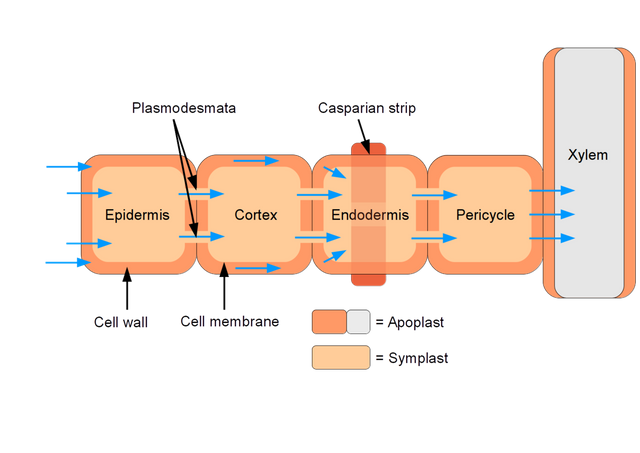
Although it was easy to find out electrical signals were involved, it has proven more difficult to find the molecular sensors directly responsible in detecting touch. In 2007, a group was able to identify cells which appear to be responsible [5].
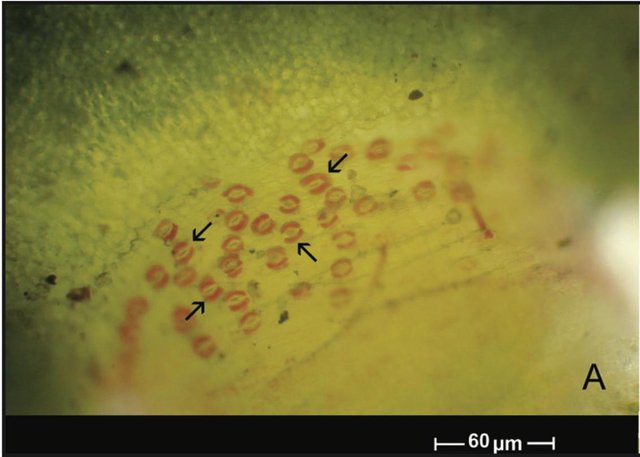
Figure from Visnovitz, Tamás, Ildikó Világi, Petra Varró, and Zoltán Kristóf. “Mechanoreceptor Cells on the Tertiary Pulvini of Mimosa Pudica L.” Plant Signaling & Behavior 2, no. 6 (November 2007): 462–66. doi:10.4161/psb.2.6.4743.
When they touched those red cells(but no other cells), they were able to observe the following:
- The plant moves its leaves
- The red cells produce an electrical pulse
The second point is key, because we know that an electrical pulse is the signal that causes the leaves to close. The exact mechanism that these red cells use to both sense touch hasn't been found yet, but at least we can tell from this information that these cells are responsible for detecting touch in Mimosa pudica.
How Do the Leaves Move?
Now, we have looked at all we know about the how the initial touch is detected, but we haven't yet answered how the electrical pulse can cause the leaves to move. This question has not been completely answered, and a few different models have been proposed. I will provide some of the evidence and proposed models.
First, let's start with a diagram of the stem and leaves:
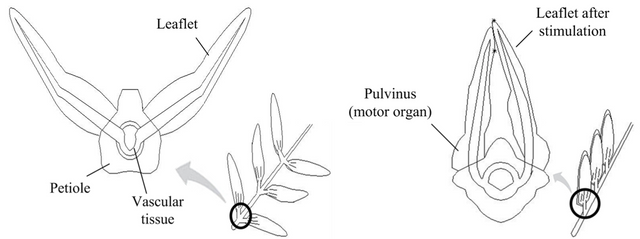
Figure from Chang, Chung-Liang, and Jin-Long Shie. “Design and Implementation of a Bionic Mimosa Robot with Delicate Leaf Swing Behavior.” Micromachines 6, no. 1 (December 23, 2014): 42–62. doi:10.3390/mi6010042.
This diagram shows a cross-section of the stem under normal and closed conditions. The pulvinus are groups of cells at the base of leaves involved in actually moving the leaves. The pulvinus contains two different layers which you can see depicted here:
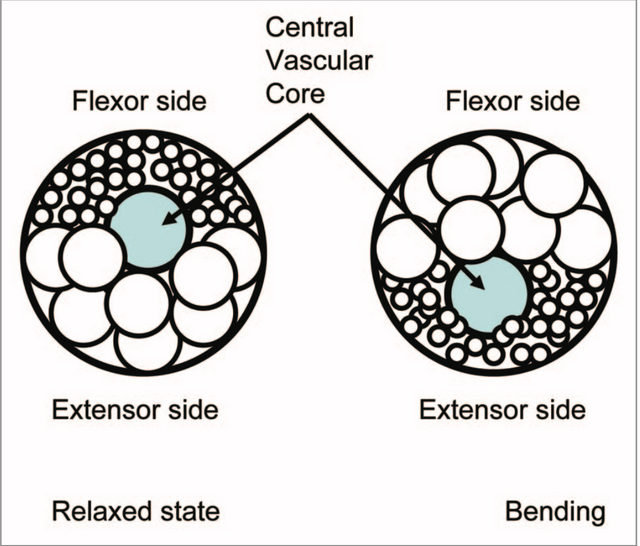
Figure from Volkov, Alexander G., Justin C. Foster, Kara D. Baker, and Vladislav S. Markin. “Mechanical and Electrical Anisotropy in Mimosa Pudica Pulvini.” Plant Signaling & Behavior 5, no. 10 (October 2010): 1211–21. doi:10.4161/psb.5.10.12658.
Now let's attempt to explain how this system works given the data. When touched, the red sensor cells send out an electrical pulse. This pulse is sent throughout the plant where it is received by a pulvinus. Since plant cells are connected through plasmodesmata, the electrical signal freely moves between the cells in the pulvinus.
That electrical signal can activate proteins proteins which transport charged molecules(ions) [6]. This means that ions can be transferred from one side of the pulvinus to the other [6]. Once ions are transferred to the opposite side of the pulvinus, water will flow into that side due to osmosis through water channels called aquaporins which have been shown to be involved [7].
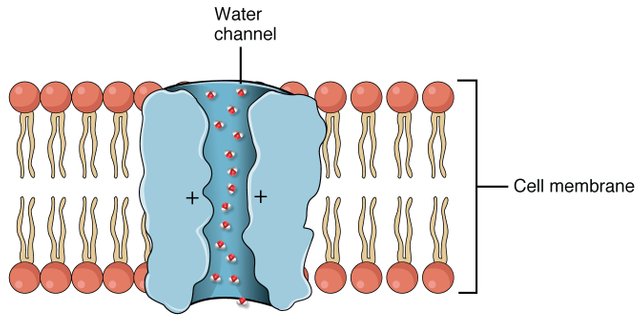
Due to the water flowing into one side of the pulvinus, we will see an increase in water pressure on that side. At the same time, we will see a corresponding decrease in pressure on the opposite side of the pulvinus. This differential change in pressure between the two sides of the pulvinus is partially responsible for moving the leaves.
Another source of movement is through a method similar to animal muscle cells. Scientists have observed that actin(one of the proteins responsible for animal muscle movement) causes at least part of the movement. First, they observed that actin filaments appear to be fragmented after movement. Going one step further, they injected plants with a drug which inhibits actin function. Afterwards, they measured a decrease in leaf movement [8]. This indicates that actin reorganization is also partly responsible for leaf movement.
A third contributor is a chemical signal known as Ricca’s factor discovered by Ricca way back in 1916. Scientists have shown that it is received by the pulvinus cells, and that it can trigger movement as well [9]. Given this data, this chemical signal must also play a role in Mimosa pudica's response.
Conclusion
Even though we were not able to come up with a simple textbook style answer to this question, I hope that this post was still useful and intersting. As in many cases in science, we don't yet have a clear explanation for exactly how this system works. We do have evidence for how parts of it work though, and that is very valuable to know. Eventually, as more evidence comes to light, it will hopefully lead us to a more unified model.
Thank you very much your valuable time spent reading, and I hope everyone has a good evening.
Previous Plant Movement Posts
If you enjoyed this post, you might be interested in a post I wrote explaining how the Venus flytrap moves. It uses some of same methods we saw for Mimosa pudica.
How Do Plants Move? The Venus Flytrap.
Sources
Images
Mimosa pudica gif:
https://upload.wikimedia.org/wikipedia/commons/f/fe/Mimosa_Pudica.gif
Symplast diagram: https://commons.wikimedia.org/wiki/File:Symplastic_and_apoplastic_water_flow_through_root.png
Aquaporin channel diagram: https://commons.wikimedia.org/wiki/File:2625_Aquaporin_Water_Channel.jpg
contrary to what most humans think the plants are more evolved because 'They are more old on earth
Plants have certainly been around for a while.
I think it's the one called "Makahiya" here in the philippines. when you touch it, the leaves closes.
Cool, that's good to know.
What a nice, well researched post! We have these here in Louisiana, USA and they are some of my favorite wild plants.
Thanks, I'm glad you enjoyed the post. They are some very fun plants to observe. I really enjoyed growing one of these last year. Sadly, I have not seen any of these in the wild.